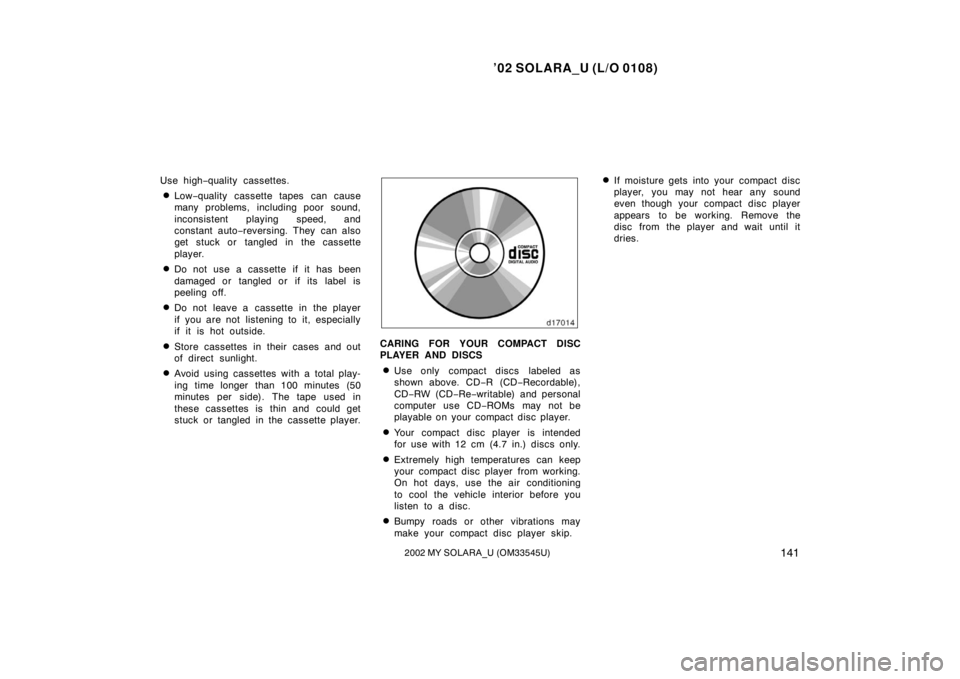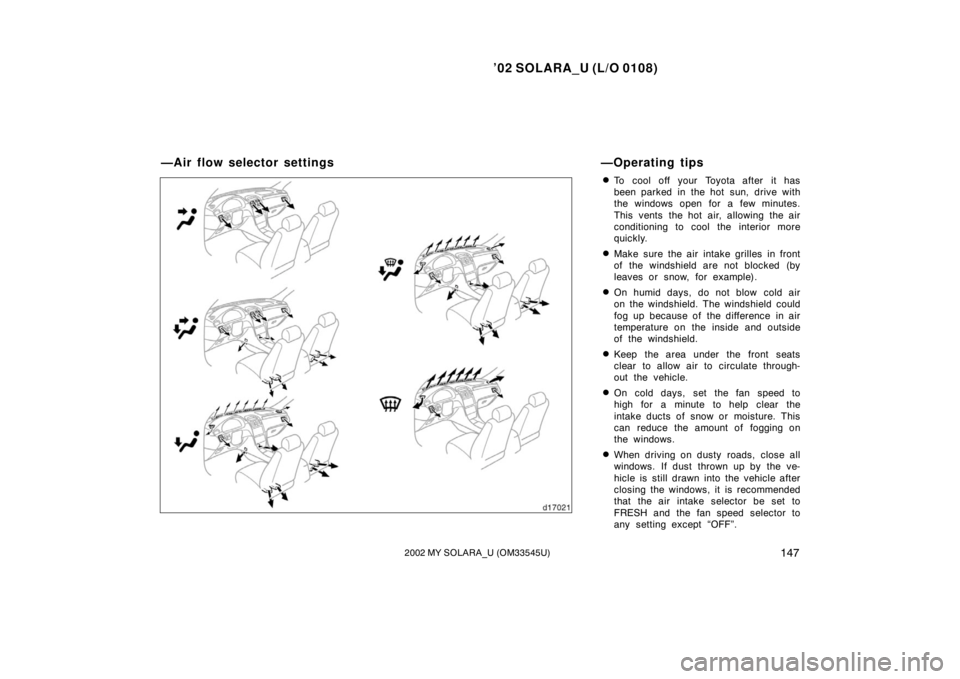Page 8 of 290
’02 SOLARA_U (L/O 0108)
42002 MY SOLARA_U (OM33545U)
1. Power rear view mirror control switches
2. Headlight and turn signal switch
3. Wiper and washer switches
4. Emergency flasher switch
5. Clock and front passenger ’s seat belt
reminder light
6. Car audio
7. Rear window and outside rear view mirror defogger switch
8. Air conditioning controls
9. Auxiliary box
10. Front ashtray 11. Traction control off switch
12. Power outlet
13. Cigarette lighter
14. Ignition switch
15. Cruise control switch
16. Tilt steering lock release lever
17. Instrument panel light control knob
Page 105 of 290
’02 SOLARA_U (L/O 0108)
1012002 MY SOLARA_U (OM33545U)
�Idling for a long period with the air
conditioning on in stop −and− go traffic.
�Towing a trailer.
NOTICE
�Do not remove the thermostat in
the engine cooling system as this
may cause the engine to overheat.
The thermostat is designed to con-
trol the flow of coolant to keep the
temperature of the engine within
the specified operating range.
� Do not continue driving with an
overheated engine. See “If your ve-
hicle overheats” in Section 4.
The tachometer indicates engine speed
in thousands of
rpm
(revolutions per minute). Use it while
driving to select correct shift points
and to prevent engine lugging and
over�revving.
Driving with the engine running too fast
causes excessive engine wear and poor
fuel economy. Remember, in most cases
the slower the engine speed, the greater
the fuel economy.
NOTICE
Do not let the indicator needle get
into the red zone. This may cause
severe engine damage.
Tachometer
Page 108 of 290

’02 SOLARA_U (L/O 0108)
1042002 MY SOLARA_U (OM33545U)
CAUTION
If the light does not turn off even
after the parking brake is released
while the engine is running, immedi-
ately stop your vehicle at a safe
place and contact your Toyota dealer.
In this case, the brakes may not work
properly and your stopping distance
will become longer. Depress the brake
pedal firmly and bring the vehicle to
an immediate stop.
(b) Driver’s Seat Belt Reminder Light
and Buzzer
This light and buzzer remind you to
buckle up the driver’s seat belt.
Once the ignition key is turned to “ON” or
“START”, the reminder light and buzzer
come on if the driver’s seat belt is not
fastened. Unless the driver fastens the
belt, the light stays on and the buzzer
stops after about 4 to 8 seconds. (c) Front Passenger ’s Seat Belt Re-
minder Light
This light reminds you to buckle up the
front passenger ’s seat belt.
Once the ignition key is turned to “ON” or
“START”, the reminder light comes on if
a passenger sits in the front passenger
seat and does not fasten the seat belt.
Unless the front passenger fastens the
belt, the light stays on. However, if a front
passenger uses an additional seat cush-
ion, the light may not flash even when the
seat belt is not buckled up.
If luggage load is placed on the front
passenger seat, depending on its weight
and how it is placed on the seat, built −in
sensors in the seat cushion may detect
the pressure, causing the reminder light to
come on.
(d) Discharge Warning Light
This light warns that the battery is being
discharged.
If it comes on while you are driving, there
is a problem somewhere in the charging
system. The engine ignition will continue to oper-
ate, however, until the battery is dis-
charged. Turn off the air conditioning,
blower, radio, etc., and drive directly to
the nearest Toyota dealer or repair shop.
NOTICE
Do not continue driving if the engine
drive belt is broken or loose.
(e) Malfunction Indicator Lamp
This lamp comes on when the ignition
key is turned to the “ON” position and
goes off after the engine starts. This
means that the warning light system is
operating properly.
If the lamp remains on, or the lamp
comes on while driving, first check the
followings.
�Empty fuel tank
If the fuel tank is empty, refuel immedi-
ately.
�Loose fuel tank cap
If the fuel tank cap is loose, securely
tighten it.
These cases are temporary malfunctions.
The malfunction indicator lamp will go off
after taking several driving trips.
Page 145 of 290

’02 SOLARA_U (L/O 0108)
1412002 MY SOLARA_U (OM33545U)
Use high−quality cassettes.
�Low −quality cassette tapes can cause
many problems, including poor sound,
inconsistent playing speed, and
constant auto− reversing. They can also
get stuck or tangled in the cassette
player.
�Do not use a cassette if it has been
damaged or tangled or if its label is
peeling off.
�Do not leave a cassette in the player
if you are not listening to it, especially
if it is hot outside.
�Store cassettes in their cases and out
of direct sunlight.
�Avoid using cassettes with a total play-
ing time longer than 100 minutes (50
minutes per side). The tape used in
these cassettes is thin and could get
stuck or tangled in the cassette player.
CARING FOR YOUR COMPACT DISC
PLAYER AND DISCS
�Use only compact discs labeled as
shown above. CD −R (CD −Recordable),
CD− RW (CD −Re −writable) and personal
computer use CD −ROMs may not be
playable on your compact disc player.
�Your compact disc player is intended
for use with 12 cm (4.7 in.) discs only.
�Extremely high temperatures can keep
your compact disc player from working.
On hot days, use the air conditioning
to cool the vehicle interior before you
listen to a disc.
�Bumpy roads or other vibrations may
make your compact disc player skip.
�If moisture gets into your compact disc
player, you may not hear any sound
even though your compact disc player
appears to be working. Remove the
disc from the player and wait until it
dries.
Page 147 of 290
’02 SOLARA_U (L/O 0108)
1432002 MY SOLARA_U (OM33545U)
OPERATION OF INSTRUMENTS AND
CONTROLS
Air conditioning system
Manual air conditioning system
Controls 144
. . . . . . . . . . . . . . . . . . . . . . . . . . . . . . . . . . . . .\
. . . . . . . . . . . .
Air flow selector settings 147
. . . . . . . . . . . . . . . . . . . . . . . . . . . . . . . . . .
Operating tips 147
. . . . . . . . . . . . . . . . . . . . . . . . . . . . . . . . . . . . \
. . . . . . .
Automatic air conditioning system Controls 150
. . . . . . . . . . . . . . . . . . . . . . . . . . . . . . . . . . . . \
. . . . . . . . . . . . .
Air flow selector settings 154
. . . . . . . . . . . . . . . . . . . . . . . . . . . . . . . . . .
Operating tips 154
. . . . . . . . . . . . . . . . . . . . . . . . . . . . . . . . . . . . \
. . . . . . .
Side vents 157
. . . . . . . . . . . . . . . . . . . . . . . . . . . . . . . . . . . . \
. . . . . . . . . . . . .
SECTION 1� 8
Page 148 of 290
’02 SOLARA_U (L/O 0108)
1442002 MY SOLARA_U (OM33545U)
1. “A/C” button
2. Air intake selector
3. Air flow selector
4. Temperature selector
5. Fan speed selector
Manual air conditioning system—
—Controls
Page 150 of 290
’02 SOLARA_U (L/O 0108)
1462002 MY SOLARA_U (OM33545U)
Air intake selector
The air intake selector button is used to
switch the air intake FRESH mode that
draws outside air into the system and RE-
CIRCULATED mode that recirculates the
air inside vehicle.
To turn the air source to RECIRCULATE
mode, press the button. The indicator will
come on. To turn the air source to FRESH
mode, press the button again. The indica-
tor will go off.
To prevent fogging up of the windshield,
the air intake mode may change automati-
cally to FRESH depending on the condi-
tion of the air conditioning system.
“A/C” button
To turn on the air conditioning, press the
“A/C” button. The “A/C” button indicator
will come on. To turn the air conditioning
off, press the button again.
If the “A/C” button indicator flashes, there
is a problem in the air conditioning system
and the air conditioning automatically
shuts off. If this happens, take your ve-
hicle to a Toyota dealer for service.
Page 151 of 290

’02 SOLARA_U (L/O 0108)
1472002 MY SOLARA_U (OM33545U)
�To cool off your Toyota after it has
been parked in the hot sun, drive with
the windows open for a few minutes.
This vents the hot air, allowing the air
conditioning to cool the interior more
quickly.
�Make sure the air intake grilles in front
of the windshield are not blocked (by
leaves or snow, for example).
�On humid days, do not blow cold air
on the windshield. The windshield could
fog up because of the difference in air
temperature on the inside and outside
of the windshield.
�Keep the area under the front seats
clear to allow air to circulate through-
out the vehicle.
�On cold days, set the fan speed to
high for a minute to help clear the
intake ducts of snow or moisture. This
can reduce the amount of fogging on
the windows.
�When driving on dusty roads, close all
windows. If dust thrown up by the ve-
hicle is still drawn into the vehicle after
closing the windows, it is recommended
that the air intake selector be set to
FRESH and the fan speed selector to
any setting except “OFF”.
—Air flow selector settings—Operating tips